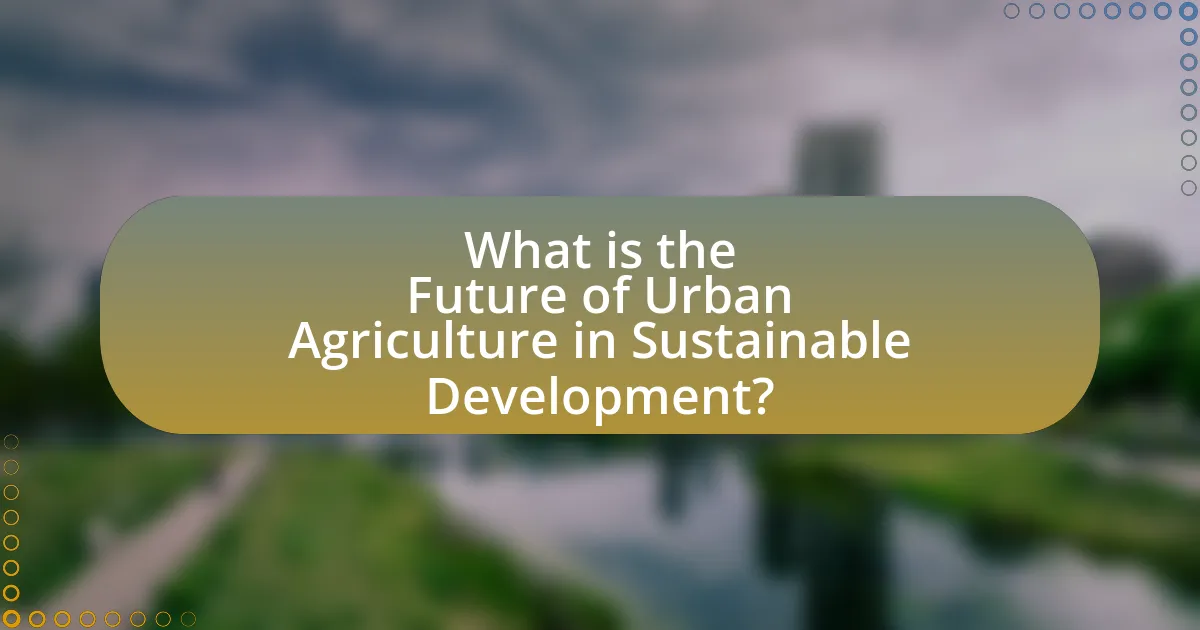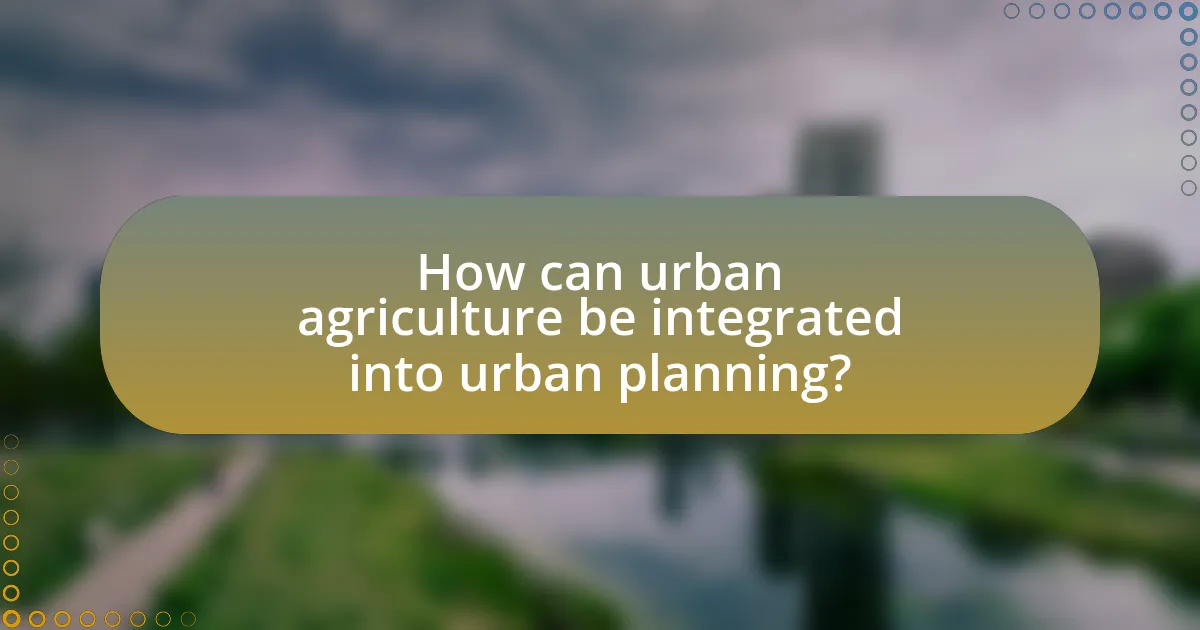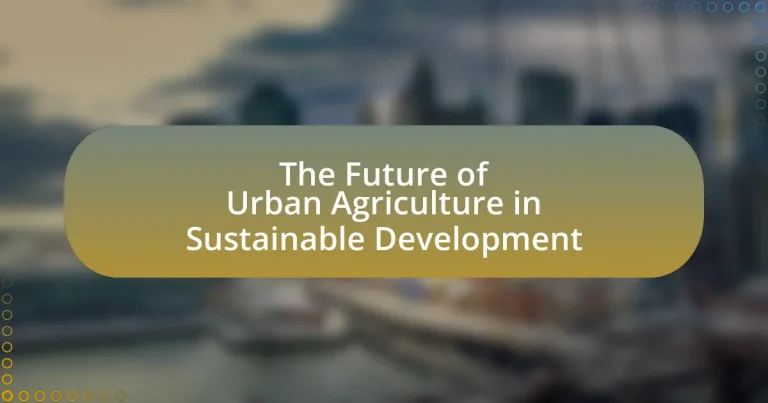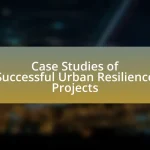The article focuses on the future of urban agriculture and its integral role in sustainable development. It highlights how urban agriculture enhances food security, reduces carbon footprints, and promotes biodiversity by utilizing underused spaces in cities. Key principles such as resource efficiency, social equity, and environmental stewardship are discussed, along with current trends like vertical farming and community gardens. The article also addresses challenges faced by urban agriculture, including regulatory barriers and economic limitations, while emphasizing the importance of education and community engagement in fostering successful urban farming initiatives.

What is the Future of Urban Agriculture in Sustainable Development?
The future of urban agriculture in sustainable development is promising, as it plays a crucial role in enhancing food security, reducing carbon footprints, and promoting biodiversity in urban areas. Urban agriculture can significantly contribute to sustainable development goals by utilizing underused spaces, such as rooftops and vacant lots, to produce food locally, thereby minimizing transportation emissions. According to a report by the Food and Agriculture Organization, urban agriculture can increase food production by up to 15% in cities, directly addressing urban food insecurity. Furthermore, integrating green spaces through urban agriculture can improve air quality and provide habitats for various species, supporting urban biodiversity.
How does urban agriculture contribute to sustainable development?
Urban agriculture contributes to sustainable development by enhancing food security, reducing carbon footprints, and promoting biodiversity. It allows cities to produce food locally, which decreases reliance on long-distance transportation, thereby lowering greenhouse gas emissions. According to a study by the Food and Agriculture Organization, urban agriculture can reduce food transportation emissions by up to 50%. Additionally, urban farms can utilize vacant lots and rooftops, transforming underused spaces into productive areas that support local ecosystems. This practice not only provides fresh produce but also fosters community engagement and education about sustainable practices, further reinforcing the principles of sustainable development.
What are the key principles of sustainable development in urban agriculture?
The key principles of sustainable development in urban agriculture include resource efficiency, social equity, and environmental stewardship. Resource efficiency emphasizes the optimal use of land, water, and energy to maximize food production while minimizing waste. Social equity focuses on ensuring access to healthy food for all community members, promoting local food systems, and supporting marginalized groups. Environmental stewardship involves practices that protect and enhance urban ecosystems, such as biodiversity conservation and soil health improvement. These principles are supported by studies indicating that urban agriculture can reduce food miles, lower greenhouse gas emissions, and improve urban resilience against climate change.
How does urban agriculture address food security in cities?
Urban agriculture enhances food security in cities by increasing local food production, thereby reducing reliance on external food sources. This practice allows urban residents to grow fresh produce within their communities, which can lead to improved access to nutritious food. According to a study by the Food and Agriculture Organization, urban agriculture can contribute to food security by providing up to 15% of the food consumed in urban areas, particularly in developing countries. Additionally, urban agriculture can mitigate food deserts, where access to affordable and healthy food is limited, by establishing community gardens and rooftop farms that supply fresh produce directly to local populations.
What are the current trends in urban agriculture?
Current trends in urban agriculture include the rise of vertical farming, community gardens, and the integration of technology such as hydroponics and aquaponics. Vertical farming utilizes limited urban space efficiently, allowing for year-round crop production and reducing transportation emissions. Community gardens foster local food production and enhance community engagement, with studies showing that they can improve food security and social cohesion. Additionally, the adoption of smart farming technologies, including sensors and data analytics, optimizes resource use and increases yield, reflecting a shift towards sustainable practices in urban environments.
How are technological advancements shaping urban agriculture?
Technological advancements are significantly shaping urban agriculture by enhancing efficiency, productivity, and sustainability. Innovations such as vertical farming, hydroponics, and aquaponics allow for food production in limited spaces, utilizing less water and reducing the need for pesticides. For instance, vertical farms can produce up to 10 times more food per square foot compared to traditional farming methods, as reported by the Food and Agriculture Organization. Additionally, precision agriculture technologies, including sensors and drones, enable urban farmers to monitor crop health and optimize resource use, leading to increased yields and reduced waste. These advancements not only address food security in urban areas but also contribute to environmental sustainability by minimizing the carbon footprint associated with food transportation.
What role do community gardens play in urban agriculture?
Community gardens serve as vital components of urban agriculture by providing accessible spaces for local food production, enhancing food security, and fostering community engagement. These gardens enable urban residents to grow fresh produce, which can reduce reliance on commercial food sources and lower food deserts in metropolitan areas. According to a study published in the Journal of Agriculture, Food Systems, and Community Development, community gardens can increase access to healthy foods by up to 40% in urban neighborhoods. Additionally, they promote social cohesion by bringing together diverse groups of people, encouraging collaboration, and building relationships among community members. This multifaceted role of community gardens underscores their importance in advancing sustainable urban agriculture initiatives.
What challenges does urban agriculture face in sustainable development?
Urban agriculture faces significant challenges in sustainable development, primarily including land access, regulatory barriers, and resource limitations. Land access is often restricted due to urbanization and competing interests, making it difficult for urban farmers to secure suitable plots for cultivation. Regulatory barriers, such as zoning laws and health regulations, can hinder the establishment and expansion of urban farms. Additionally, resource limitations, including water scarcity and inadequate funding, pose obstacles to the viability and scalability of urban agriculture initiatives. These challenges are documented in studies, such as the “Urban Agriculture: A Global Analysis” by the Food and Agriculture Organization, which highlights the need for supportive policies and infrastructure to promote sustainable urban farming practices.
How do regulatory policies impact urban agriculture initiatives?
Regulatory policies significantly influence urban agriculture initiatives by establishing the legal framework within which these projects operate. These policies can either facilitate or hinder urban farming through zoning laws, land use regulations, and health and safety standards. For instance, cities that adopt supportive policies, such as allowing community gardens in residential zones, enable greater participation in urban agriculture, which can lead to increased food security and community engagement. Conversely, restrictive policies, such as prohibiting livestock in urban areas or imposing stringent building codes, can limit the scope and viability of urban agriculture projects. Evidence from cities like Detroit, which has implemented policies to promote urban farming, shows a correlation between supportive regulations and the growth of local food systems, demonstrating the critical role of regulatory frameworks in shaping urban agriculture’s success.
What are the economic barriers to implementing urban agriculture?
The economic barriers to implementing urban agriculture include high initial investment costs, limited access to financing, and competition for land use. High initial investment costs arise from the need for infrastructure, equipment, and technology, which can deter potential urban farmers. Limited access to financing is a significant issue, as many urban agriculture projects struggle to secure loans or grants due to perceived risks and lack of collateral. Additionally, competition for land use in urban areas often prioritizes commercial and residential development over agricultural initiatives, making it difficult for urban agriculture to establish a foothold. These factors collectively hinder the growth and sustainability of urban agriculture projects.

How can urban agriculture be integrated into urban planning?
Urban agriculture can be integrated into urban planning by incorporating green spaces, community gardens, and agricultural zones within city layouts. This integration promotes food security, enhances biodiversity, and improves urban resilience. For instance, cities like Detroit have successfully implemented urban farming initiatives that utilize vacant lots, demonstrating that urban agriculture can revitalize communities while providing fresh produce. Additionally, policies that support zoning for urban farms and provide incentives for local food production can further embed agriculture into the urban fabric, as seen in cities like Toronto, which has established guidelines for urban agriculture in its official plan.
What strategies can cities adopt to promote urban agriculture?
Cities can adopt several strategies to promote urban agriculture, including implementing supportive policies, providing access to land, and facilitating community engagement. Supportive policies can include zoning regulations that allow for urban farming and financial incentives such as grants or tax breaks for urban agriculture initiatives. Access to land can be enhanced through the use of vacant lots, rooftops, and public spaces designated for community gardens or urban farms. Community engagement can be fostered through educational programs and workshops that raise awareness about the benefits of urban agriculture, encouraging local participation and investment. These strategies have been shown to increase food security, enhance community resilience, and promote sustainable practices in urban environments.
How can zoning laws be modified to support urban farming?
Zoning laws can be modified to support urban farming by allowing agricultural activities in residential and commercial zones. This modification can include designating specific areas for community gardens, rooftop farms, and vertical farming initiatives, which can enhance local food production and sustainability. For instance, cities like Toronto have amended their zoning bylaws to permit urban agriculture in various districts, leading to increased access to fresh produce and community engagement. Additionally, providing incentives such as tax breaks or grants for urban farming projects can further encourage compliance and participation among residents and businesses.
What partnerships are essential for successful urban agriculture projects?
Successful urban agriculture projects require partnerships with local governments, community organizations, educational institutions, and private sector stakeholders. Local governments provide regulatory support and access to land, while community organizations facilitate engagement and mobilization of residents. Educational institutions contribute research, training, and innovation, enhancing the skills of urban farmers. Private sector stakeholders, including businesses and investors, offer funding, resources, and market access, which are crucial for sustainability and scalability. These partnerships collectively create a supportive ecosystem that fosters the growth and success of urban agriculture initiatives.
What role does education play in urban agriculture?
Education plays a crucial role in urban agriculture by equipping individuals with the knowledge and skills necessary for effective farming practices in urban settings. It fosters awareness of sustainable agricultural techniques, such as permaculture and hydroponics, which are essential for maximizing limited urban space. Research indicates that educational programs can significantly increase community engagement and participation in urban farming initiatives, leading to improved food security and environmental sustainability. For instance, a study by the University of California found that urban agriculture education programs increased participants’ gardening skills by 60%, demonstrating the direct impact of education on urban agricultural productivity and community resilience.
How can schools incorporate urban agriculture into their curricula?
Schools can incorporate urban agriculture into their curricula by integrating hands-on gardening projects, which provide students with practical experience in growing food. This approach not only teaches students about plant biology and ecology but also emphasizes the importance of sustainability and local food systems. Research shows that experiential learning in agriculture can enhance student engagement and understanding of environmental issues, as evidenced by programs like the Edible Schoolyard Project, which has successfully implemented garden-based learning in schools across the United States. By aligning these projects with subjects such as science, math, and social studies, schools can create a multidisciplinary curriculum that fosters a deeper appreciation for urban agriculture and its role in sustainable development.
What community outreach programs can enhance urban agriculture awareness?
Community outreach programs that can enhance urban agriculture awareness include educational workshops, community gardens, and school-based agriculture initiatives. Educational workshops provide hands-on training and information about sustainable practices, which can increase knowledge and interest in urban agriculture. Community gardens serve as practical examples of urban farming, fostering community engagement and collaboration while demonstrating the benefits of local food production. School-based agriculture initiatives integrate farming concepts into the curriculum, promoting awareness among students and their families. Research indicates that such programs can significantly improve community knowledge and participation in urban agriculture, as evidenced by studies showing increased local food production and community cohesion in areas with active outreach efforts.

What are the future prospects for urban agriculture in sustainable development?
The future prospects for urban agriculture in sustainable development are promising, as it can significantly enhance food security, reduce carbon footprints, and promote biodiversity. Urban agriculture is projected to grow due to increasing urban populations and the need for local food sources, with estimates suggesting that urban farming could supply up to 30% of the food needs in cities by 2030. Additionally, initiatives like vertical farming and community gardens are gaining traction, supported by policies aimed at integrating agriculture into urban planning. Research indicates that urban agriculture can reduce transportation emissions by up to 50%, thereby contributing to climate change mitigation efforts.
How can urban agriculture adapt to climate change?
Urban agriculture can adapt to climate change by implementing resilient farming practices, such as using drought-resistant crops and optimizing water management techniques. These practices help mitigate the impacts of extreme weather events and changing climate conditions. For instance, integrating rainwater harvesting systems can enhance water availability during dry spells, while selecting native or climate-adapted plant varieties can improve yield stability. Research indicates that urban farms employing these strategies can reduce vulnerability to climate variability, thereby contributing to food security in urban areas.
What innovative practices can enhance resilience in urban agriculture?
Innovative practices that can enhance resilience in urban agriculture include vertical farming, aquaponics, and community-supported agriculture (CSA). Vertical farming utilizes controlled environments to grow crops in stacked layers, maximizing space and reducing resource use; studies show that it can increase yield by up to 10 times compared to traditional farming methods. Aquaponics combines fish farming with plant cultivation, creating a symbiotic environment that reduces water usage by 90% compared to conventional agriculture. Community-supported agriculture fosters local food systems by connecting consumers directly with farmers, which can increase food security and reduce transportation emissions. These practices collectively contribute to sustainable urban development by promoting efficient resource use and enhancing food accessibility.
How can urban agriculture contribute to biodiversity in cities?
Urban agriculture can significantly enhance biodiversity in cities by creating habitats for various species, including pollinators, birds, and beneficial insects. These agricultural practices, such as community gardens and rooftop farms, introduce diverse plant species that support local ecosystems. Research indicates that urban green spaces, including agricultural areas, can increase species richness by providing food and shelter, thereby promoting ecological interactions. For instance, a study published in the journal “Urban Ecosystems” found that urban gardens can host up to 50% more plant species compared to surrounding urban areas, demonstrating their role in fostering biodiversity.
What best practices should be followed for successful urban agriculture?
Successful urban agriculture requires implementing best practices such as selecting appropriate crops, utilizing efficient water management techniques, and engaging the community. Choosing crops that are well-suited to the local climate and soil conditions enhances yield and sustainability. Efficient water management, including rainwater harvesting and drip irrigation, conserves resources and ensures plants receive adequate hydration. Community engagement fosters support, knowledge sharing, and collaboration, which are vital for the long-term success of urban agriculture initiatives. These practices are supported by studies indicating that urban agriculture can significantly contribute to food security and environmental sustainability in urban settings.
How can urban farmers effectively utilize limited space?
Urban farmers can effectively utilize limited space by implementing vertical farming techniques, which allow for the cultivation of crops in stacked layers. This method maximizes the use of available square footage and can increase yield per square meter significantly; for instance, vertical farms can produce up to 10 times more food than traditional farming methods in the same area. Additionally, urban farmers can incorporate container gardening, hydroponics, and aquaponics, which require less land and can be set up in small areas such as balconies or rooftops. Research indicates that these methods not only optimize space but also reduce water usage by up to 90% compared to conventional agriculture, making them sustainable options for urban environments.
What are the most effective methods for engaging local communities in urban agriculture?
The most effective methods for engaging local communities in urban agriculture include participatory planning, education and training programs, and community partnerships. Participatory planning allows community members to have a voice in the design and implementation of urban agriculture projects, fostering ownership and commitment. Education and training programs equip residents with the necessary skills and knowledge to successfully engage in urban farming, which has been shown to increase participation rates. Community partnerships, such as collaborations with local organizations and businesses, enhance resources and support for urban agriculture initiatives, leading to greater community involvement. Research indicates that these methods significantly improve community engagement and the sustainability of urban agriculture projects, as evidenced by case studies in cities like Detroit and New York, where such strategies have led to increased food security and community cohesion.


